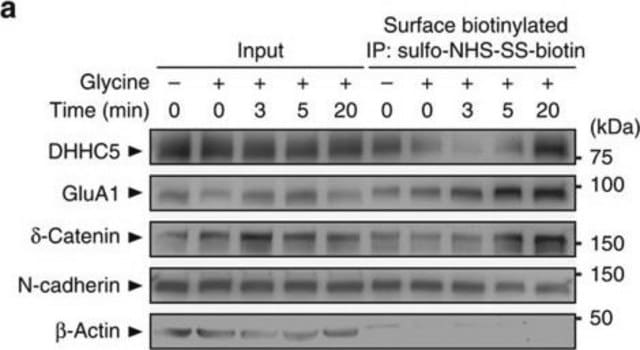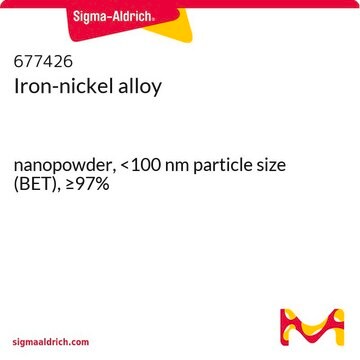추천 제품
생물학적 소스
rabbit
Quality Level
항체 형태
affinity isolated antibody
항체 생산 유형
primary antibodies
클론
polyclonal
정제법
affinity chromatography
종 반응성
human, mouse, rat
기술
immunohistochemistry: suitable (paraffin)
western blot: suitable
NCBI 수납 번호
UniProt 수납 번호
배송 상태
wet ice
타겟 번역 후 변형
unmodified
유전자 정보
human ... GRIA1(2890)
mouse ... Gria1(14799)
rat ... Gria1(50592)
일반 설명
Glutamate receptors (GluRs) are a diverse group responsible for mediating most of the excitatory synaptic transmission in the CNS of vertebrates. They can be categorized as ionotropic or metabotropic and subcategorized by their agonist preferences (NMDA, AMPA or Kainic acid). There are four types of AMPA selective GluR subunits (GluR1, GluR2, GluR3 and GluR4). Tetrameric or pentameric combinations of different subunits contributes to the functional diversity of AMPA receptors. AMPA receptors mediate fast synaptic current at most excitatory synapses, with stoichiometry characterized by subtype composition. The critical residue controlling calcium permeability is in the pore loop region. In GluR1, GluR3, and GluR4, this position is occupied by a Gln residue. The insertion or removal of GluR1/GluR4 oligomeric channels from postsynaptic membranes appears to be LTP/LTD activity dependent while GluR2/GluR3 oligomers are continuously cycling.
특이성
This antibody recognizes the extracellular domain of GluR1.
면역원
KLH-conjugated linear peptide corresponding to the extracellular domain of rat GluR1.
애플리케이션
Anti-GluR1 Antibody is a highly specific rabbit polyclonal antibody, that targets GluR1 & has been tested in western blotting & IHC (Paraffin).
Immunohistochemistry Analysis: A 1:1,000 dilution from a representative lot detected GluR1 in human brain and human cerebellum tissue.
품질
Evaluated by Western Blotting in rat brain tissue lysate.
Western Blotting Analysis: 2.0 µg/mL of this antibody detected GluR1 in 10 µg of rat brain tissue lysate.
Western Blotting Analysis: 2.0 µg/mL of this antibody detected GluR1 in 10 µg of rat brain tissue lysate.
표적 설명
~110 kDa observed
결합
Replaces: PC246-100UG
Not finding the right product?
Try our 제품 선택기 도구.
Storage Class Code
12 - Non Combustible Liquids
WGK
WGK 1
Flash Point (°F)
Not applicable
Flash Point (°C)
Not applicable
시험 성적서(COA)
제품의 로트/배치 번호를 입력하여 시험 성적서(COA)을 검색하십시오. 로트 및 배치 번호는 제품 라벨에 있는 ‘로트’ 또는 ‘배치’라는 용어 뒤에서 찾을 수 있습니다.
Jennifer L Sanderson et al.
The Journal of neuroscience : the official journal of the Society for Neuroscience, 38(11), 2863-2876 (2018-02-15)
Neuronal information processing requires multiple forms of synaptic plasticity mediated by NMDARs and AMPA-type glutamate receptors (AMPARs). These plasticity mechanisms include long-term potentiation (LTP) and long-term depression (LTD), which are Hebbian, homosynaptic mechanisms locally regulating synaptic strength of specific inputs
Núria Martín-Flores et al.
Cell death & disease, 11(7), 569-569 (2020-08-01)
RTP801/REDD1 is a stress-responsive protein that mediates mutant huntingtin (mhtt) toxicity in cellular models and is up regulated in Huntington's disease (HD) patients' putamen. Here, we investigated whether RTP801 is involved in motor impairment in HD by affecting striatal synaptic
Tao Wu et al.
Journal of biomedical science, 26(1), 79-79 (2019-10-21)
Neuronal activity-induced changes in gene expression patterns are important mediators of neuronal plasticity. Many neuronal genes can be activated or inactivated in response to neuronal depolarization. Mechanisms that activate gene transcription are well established, but activity-dependent mechanisms that silence transcription
Katherine J Sellers et al.
Alzheimer's & dementia : the journal of the Alzheimer's Association, 14(3), 306-317 (2017-10-23)
Synapse loss is the structural correlate of the cognitive decline indicative of dementia. In the brains of Alzheimer's disease sufferers, amyloid β (Aβ) peptides aggregate to form senile plaques but as soluble peptides are toxic to synapses. We previously demonstrated
Ayush Singh et al.
Journal of Alzheimer's disease : JAD, 78(4), 1661-1678 (2020-11-14)
Certain individuals, here referred to as Non-Demented with Alzheimer Neuropathology (NDAN), do not show overt neurodegeneration (N-) and remain cognitively intact despite the presence of plaques (A+) and tangles (T+) that would normally be consistent with fully symptomatic Alzheimer's disease
자사의 과학자팀은 생명 과학, 재료 과학, 화학 합성, 크로마토그래피, 분석 및 기타 많은 영역을 포함한 모든 과학 분야에 경험이 있습니다..
고객지원팀으로 연락바랍니다.







